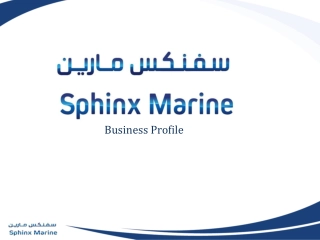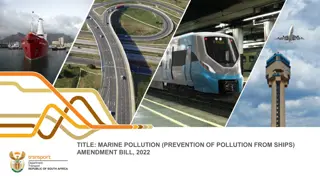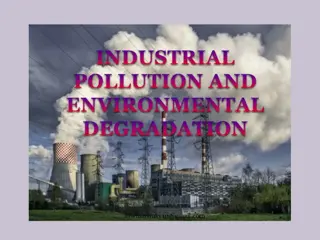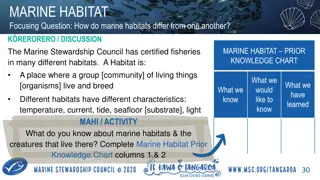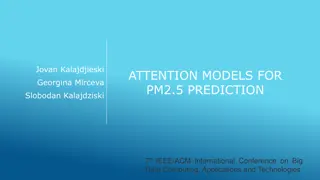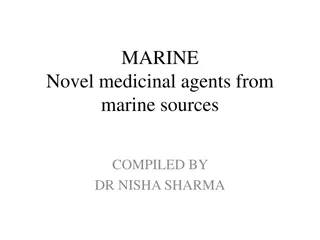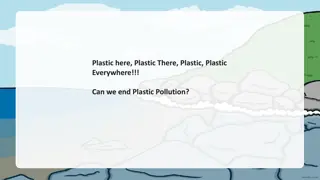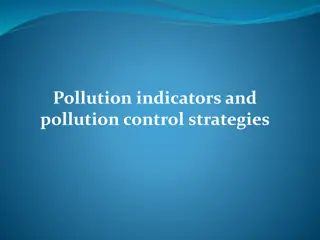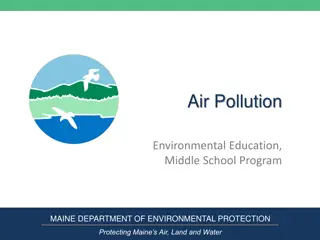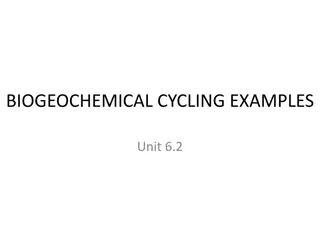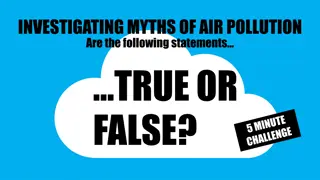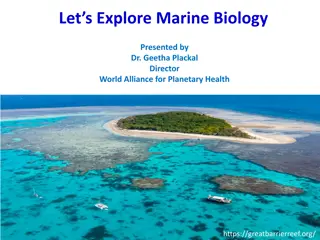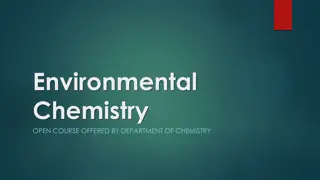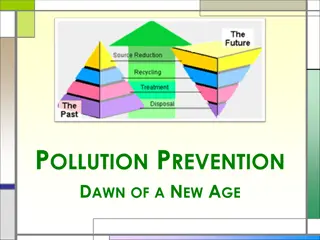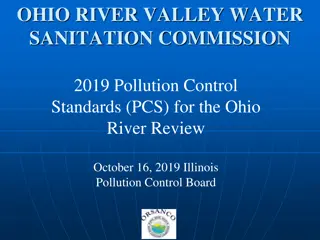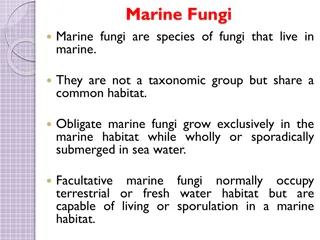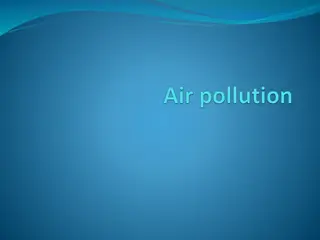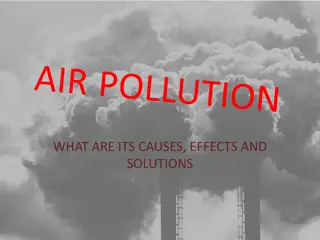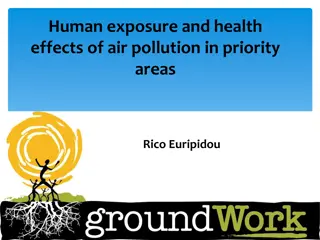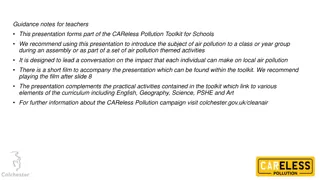
Marine Pollution - Causes, Impact, and Solutions
Marine pollution poses a serious threat to ocean ecosystems, caused by factors such as oil spills, untreated sewage, and overfishing. Learn about the various sources and effects of marine pollution, and explore examples and ways to reduce pollutant inputs for a healthier marine environment.
Download Presentation

Please find below an Image/Link to download the presentation.
The content on the website is provided AS IS for your information and personal use only. It may not be sold, licensed, or shared on other websites without obtaining consent from the author. If you encounter any issues during the download, it is possible that the publisher has removed the file from their server.
You are allowed to download the files provided on this website for personal or commercial use, subject to the condition that they are used lawfully. All files are the property of their respective owners.
The content on the website is provided AS IS for your information and personal use only. It may not be sold, licensed, or shared on other websites without obtaining consent from the author.
E N D
Presentation Transcript
www.studymafia.org Marine Pollution Submitted To: www.studymafia.org Submitted By: www.studymafia.org
What is Marine Pollution ?? Marine pollution includes a range of threats including from land-based sources, oil spills, untreated sewage, heavy siltation, eutrophication (nutrient enrichment), persistent organic pollutants (POP s), heavy metals from mine tailings and other sources, acidification, radioactive substances, marine litter, overfishing and destruction of coastal and marine habitats. invasive species,
Health of Marine Life Contd.
Health of Marine Life In 2002, more than 70% of the tropical and temperate coasts were heavily impacted by development of resorts, hotels, settlements and other human infrastructure. By 2032, this figure may have risen to as much as 90% (range 81- 95%) (Data from GLOBIO, prepared for this report, www.globio.info), with substantial increases in discharges of nutrients and silt into the marine environment. The combined cumulative effects of coastal overfishing, marine pollution and coastal development may impact the long-term productivity of the coastal zone. This, in turn, may lower the capacity of these systems to support human livelihoods in the coastal zone. Animals can be poisoned or suffer internal damage from ingesting oil. Effects include ulcers and damage to red blood cells, kidneys, liver and to the immune system. Oil vapours can injure to eyes and lungs, and can be particularly hazardous while new oil is still coming to the surface and vapours are evaporating. If vapours are severe enough, marine mammals may become "sleepy" and drown.
Some Examples of Marine Pollution New River in California: The water at this point is three colors- dark green, white (foam), and milky brown/green. The septic stench is pungent, Fecal coliforms and fecal streptococci have been consistently detected in the New River . Acid mine drainage causes severe environmental problems in Rio Tinto river, Spain. According to the United States Environmental Protection Agency, mining has contaminated portions of the headwaters of over 40% of watersheds in the western continental US. Much of this pollution finishes up in the sea. Septic river. Contd.
Ways of Pollutant Inputs There are five main types of inputs of pollution into the ocean Direct discharge of waste into the oceans, Runoff into the waters due to rain Ship Pollution Atmospheric Pollution Deep Sea Mining
Direct Discharge Pollutants enter rivers and the sea directly from urban sewerage and industrial waste discharges, sometimes in the form of hazardous and toxic wastes Inland mining for copper, gold. etc., is another source of marine pollution. Most of the pollution is simply soil, which ends up in rivers flowing to the sea. Some minerals discharged in the course of the mining can cause problems, such as copper, a common industrial pollutant, which can interfere with the life history and development of coral polyps. Mining has a poor environmental track record.
Surface Run-off Surface runoff from farming, as well as urban runoff and runoff from the construction of roads, buildings, ports, channels, and harbours, can carry soil and particles laden with carbon, nitrogen, phosphorus, and minerals. This nutrient-rich water can cause fleshy algae and phytoplankton to thrive in coastal areas, known as algal blooms, which have the potential to create hypoxic conditions by using all available oxygen Polluted runoff from roads and highways can be a significant source of water pollution in coastal areas. About 75 percent of the toxic chemicals that flow into Puget Sound are carried by storm water that runs off paved roads and driveways, rooftops, yards and other developed land.
Ships pollution Ships can pollute waterways and oceans in many ways: Oil spills can have devastating effects. While being toxic to marine life, polycyclic aromatic components in crude oil, are very difficult to clean up, and last for years in the sediment and marine environment. Discharge of cargo residues from bulk carriers can pollute ports, waterways and oceans. In many instances vessels intentionally discharge illegal wastes despite foreign and domestic regulation prohibiting such actions. It has been estimated that container ships lose over 10,000 containers at sea each year (usually during storms). Ships also create noise pollution that disturbs natural wildlife hydrocarbons (PAHs), the
Atmospheric pollution Wind blown dust and debris, including plastic bags, are blown seaward from landfills and other areas. Dust from the Sahara moves into the Caribbean and Florida during the warm season . Since 1970, dust outbreaks have worsened due to periods of drought in Africa. The USGS links dust events to a decline in the health of coral reefs across the Caribbean and Florida Climate change is raising ocean temperatures and raising levels of carbon dioxide in the atmosphere. These rising levels of carbon dioxide are acidifying the oceans.
Deep Sea Mining Ocean mining sites are usually around large areas of polymetallic nodules or active and extinct hydrothermal vents at about 1,400 - 3,700 meters below the ocean s surface. The deposits are mined using either hydraulic pumps or bucket systems that take ore to the surface to be processed. Removing parts of the sea floor disturbs the habitat of benthic organisms, possibly, depending on the type of mining and location, causing permanent disturbances. Near bottom plumes occur when the tailings are pumped back down to the mining site. Surface plumes cause a more serious problem. Depending on the size of the particles and water currents the plumes could spread over vast areas. Aside from direct impact of mining the area, leakage, spills and corrosion would alter the mining area s chemical makeup.
Human Impacts On Marine Environments 1. Eutrophication An increase in chemical nutrients, typically compounds containing nitrogen or phosphorus, in an ecosystem. It can result in an increase in the ecosystem's primary productivity(excessive plant growth and decay), and further effects including lack of oxygen. The biggest culprit are rivers that empty into the ocean, and with it the many chemicals used as fertilizers in agriculture as well as waste from livestock and humans. An excess of oxygen depleting chemicals in the water can lead to hypoxia and the creation of a dead zone.
2. Acidification The oceans are normally a natural carbon sink, absorbing carbon dioxide from the atmosphere. Structures made of calcium carbonate may become vulnerable to dissolution, affecting corals and the ability of shell fish to form shells. Oceans and coastal ecosystems have removed about 25% of the carbon dioxide emitted by human activities between 2000 and 2007 and about half the anthropogenic CO2released since the start of the industrial revolution
3. Plastic Debris 80 % of marine debris is plastic - a component that has been rapidly accumulating since the end of World War II. Discarded plastic bags, six pack rings and other forms of plastic waste which finish up in the ocean present dangers to wildlife and fisheries. Aquatic life can be threatened through entanglement, suffocation, and ingestion. Fishing nets, usually made of plastic, can be left or lost in the ocean by fishermen. Contd.
3. Plastic Debris Plastic debris tends to accumulate at the center of ocean .In particular, the Great Pacific Garbage Patch has a very high level of suspended in the upper water column. plastic particulate In samples taken in 1999, the mass of plastic exceeded that of zooplankton (the dominant animal life in the area) by a factor of six. Midway A toll, in common with all the Hawaiian Islands, receives substantial amounts of debris from the garbage patch. Ninety percent plastic, this debris accumulates on the beaches of Midway where it becomes a hazard to the bird population of the island.
4. Other Toxins Apart from plastics, there are particular problems with other toxins that do not disintegrate rapidly in the marine environment. Examples of persistent toxins are PCBs, DDT, pesticides, furans, dioxins, phenols and radioactive waste. Heavy metals are metallic chemical elements that have a relatively high density and are toxic or poisonous at low concentrations. Examples are mercury, lead, nickel, arsenic and cadmium. Such toxins can accumulate in the tissues of many species of aquatic life in a process called bioaccumulation. They are also known to accumulate in benthic environments, such as estuaries and bay muds: a geological record of human activities of the last century.
5. Noise Pollution Marine life can be susceptible to noise or sound pollution from sources such as passing ships, oil exploration seismic surveys, and naval low-frequency active sonar. Sound travels more rapidly and over larger distances in the sea than in the atmosphere. Marine animals, such as cetaceans, often have weak eyesight, and live in a world largely defined by acoustic information. This applies also to many deeper sea fish, who live in a world of darkness. Between 1950 and 1975, ambient noise in the ocean increased by about ten decibels (that is a ten-fold increase). Noise also makes species communicate louder, which is called the Lombard vocal response.
6. Mitigation Either the human population is reduced, A way is found to reduce the ecological footprint left behind by the average human. The second way is for humans, individually, to pollute less. That requires social and political will the most important strategy for reducing marine pollution is education Awareness Research Dissemination
How to Protect Marine Life ? From Oil Pollution From Garbage Pollution From Accidental Loss or Discharge of Fishing Gear Plan to reduce and store your garbage Garbage Waste Management On-board Shore facilities
Oil Pollution The Discharge Of Oily Mixtures Into The Sea Is Prohibited Discharge of oily mixtures is allowed while in transit provided the fishing vessel has in operation oil filtering/separating equipment that ensures the oil content is less than 15 parts of oil to one million parts of water (15ppm).. All fishing vessels over 400 tons are required to be fitted with this type of equipment which must also be approved to meet standards set by the International Maritime Organization. Reduce The Potential Of An Oil Discharge All leakage of fuel oil, lubricating oil and cooling water should be dealt with as soon as it is detected. A drip tray should be fitted under all engines with suitable drainage to a holding tank or drum for disposal ashore. Ensure that engine rooms and other machinery spaces are fitted with sump plumbing so that any leakage is collected in the sump instead of the bilge.
Garbage Pollution There are many types of waste generated on board fishing vessels that are prohibited from discharge at sea including Trawl and fishing nets Synthetic rope Plastic sheeting "Six pack" holders Fibreglass Strapping bands Plastic "ice" bags Bait gaskets Paints
Accidental Loss or Discharge of Fishing Gear Lost fishing gear may harm the marine environment or create a navigational hazard. Many marine animals (including target fish species) die as a result of becoming entangled in, or ingesting discarded plastic packing straps; netting of all kinds. Plastics which shatter into smaller fragments are also mistaken for food or ingested accidentally. Garbage such as rope and plastic material can also get caught in propeller shafts or block water intakes causing major damage and expensive repairs.
Plan To Reduce And Store Your Garbage The best way to avoid the discharge of garbage, and the possibility of fines, is to reduce the amount of potential garbage taken onboard and the amount of garbage generated through the use of packaged items. Where possible, it is suggested that fisherman consider how much waste a product will generate when buying products. Bulk packaging, reusable and recyclable packaging and avoiding plastic packaging, unless it is reusable or recyclable, are all ways to reduce the amount of waste generated.
Garbage Waste Management Onboard Every fishing vessel of 100 gross tonnage and above, and every fishing vessel certified to carry 15 or more persons is also now required to carry a Garbage Management Plan. The Garbage Management Plan contains procedures for collecting, storing, processing and disposing of garbage, including the use of appropriate garbage handling equipment such as storage containers, compactors or incinerators.
Shore Facilities If shore facilities are not adequate for the disposal of oil or garbage, let the marina owner or port authority know. State/Territory and local officials should also be notified of the inadequate facilities. If enough fishermen express concern, upgrading of the facilities is more likely to occur.
Solution to pollution Reduce input of toxic pollutants Treat sewage primary, secondary and tertiary treatment Ban dumping of wastes and raw sewage in the sea Ban ocean dumping of sludge and hazardous dredged material Protect sensitive areas from development, oil drilling, and oil shipping Regulate coastal development

